Sepsis Infection: Causes, Incidence, and Treatment
VerifiedAdded on 2023/06/04
|10
|2709
|121
AI Summary
Sepsis is a serious infection of the bloodstream that can lead to organ failure and death. This article discusses the causes, incidence, and treatment of sepsis, as well as resources available to support diagnosis. It also provides information on sepsis in Australia and its impact on healthcare institutions.
Contribute Materials
Your contribution can guide someone’s learning journey. Share your
documents today.
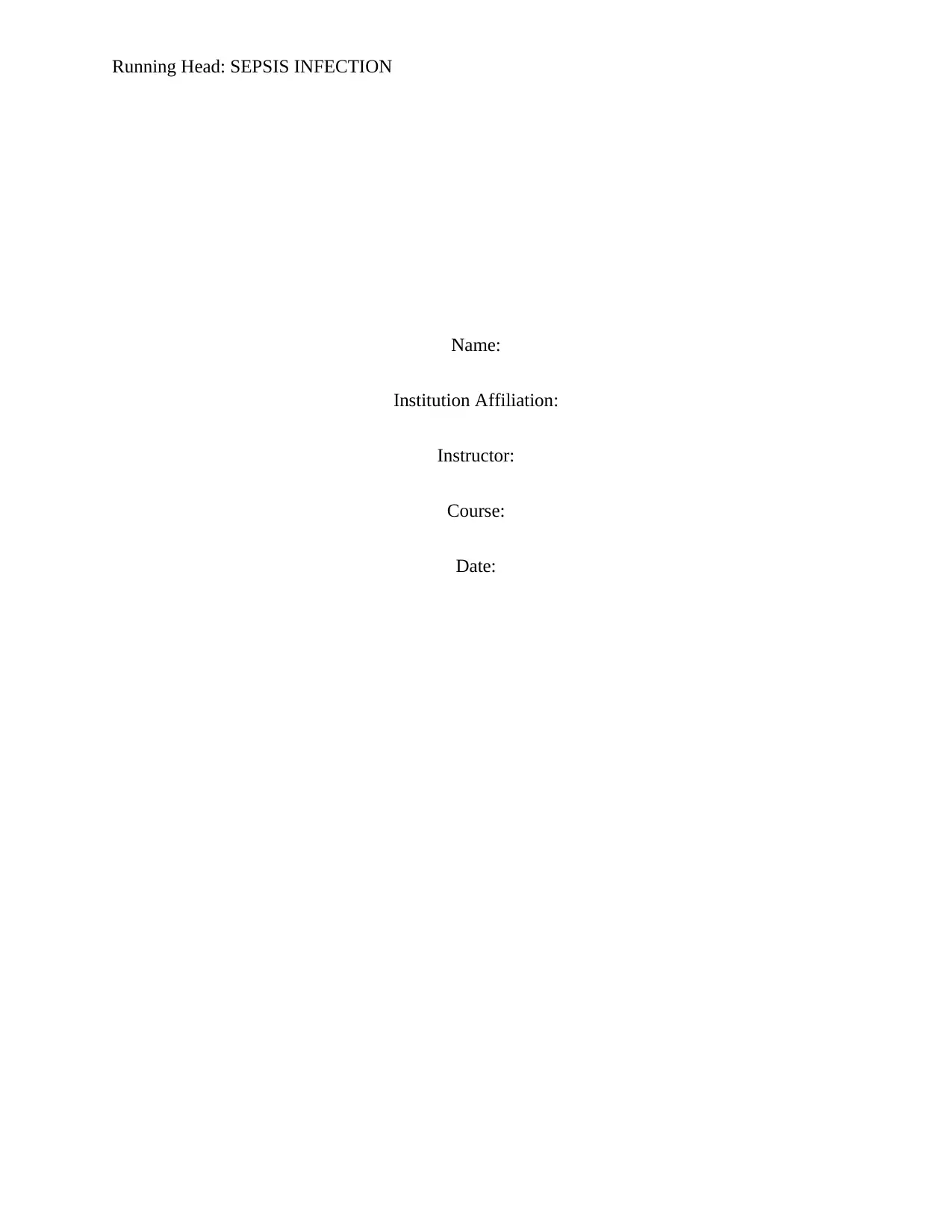
Running Head: SEPSIS INFECTION
Name:
Institution Affiliation:
Instructor:
Course:
Date:
Name:
Institution Affiliation:
Instructor:
Course:
Date:
Secure Best Marks with AI Grader
Need help grading? Try our AI Grader for instant feedback on your assignments.
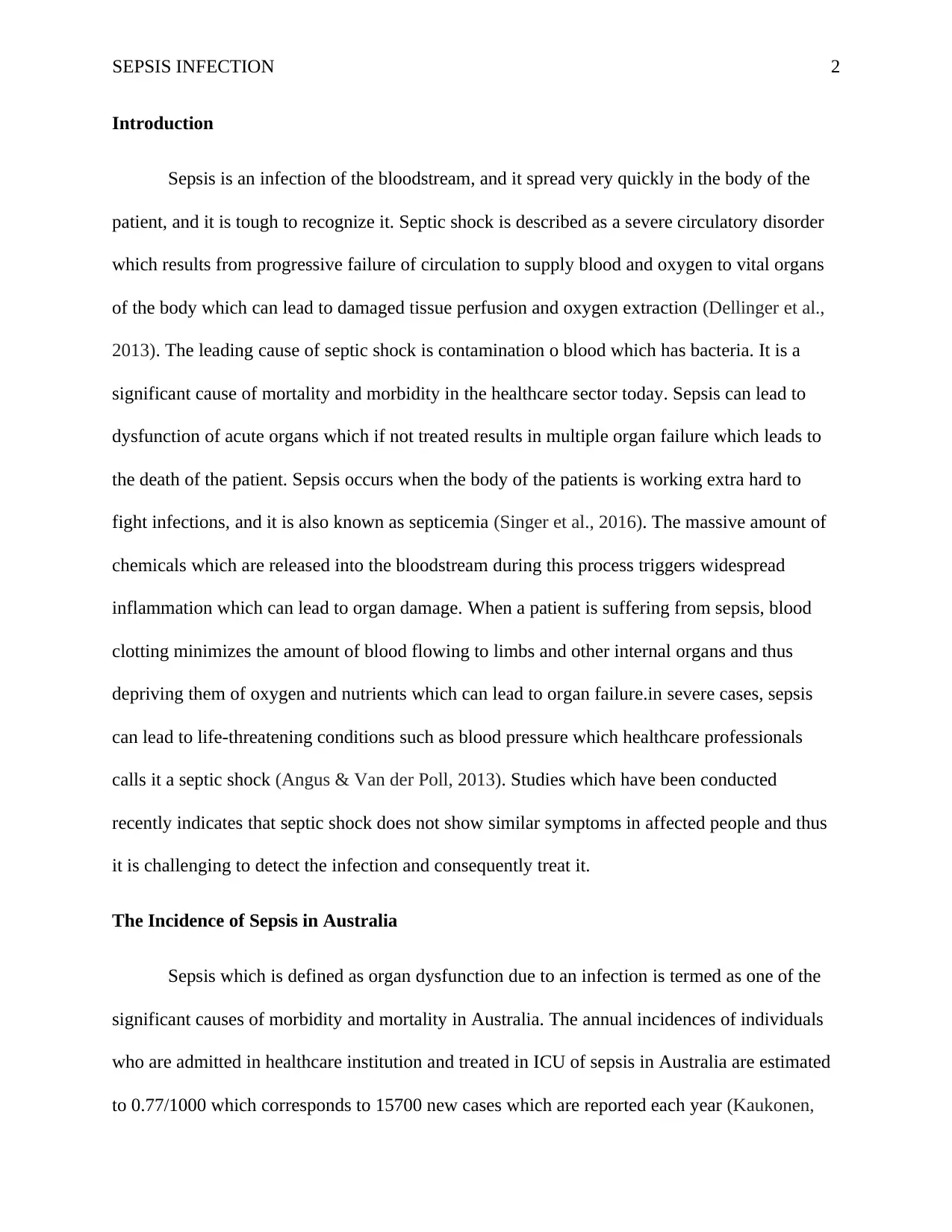
SEPSIS INFECTION 2
Introduction
Sepsis is an infection of the bloodstream, and it spread very quickly in the body of the
patient, and it is tough to recognize it. Septic shock is described as a severe circulatory disorder
which results from progressive failure of circulation to supply blood and oxygen to vital organs
of the body which can lead to damaged tissue perfusion and oxygen extraction (Dellinger et al.,
2013). The leading cause of septic shock is contamination o blood which has bacteria. It is a
significant cause of mortality and morbidity in the healthcare sector today. Sepsis can lead to
dysfunction of acute organs which if not treated results in multiple organ failure which leads to
the death of the patient. Sepsis occurs when the body of the patients is working extra hard to
fight infections, and it is also known as septicemia (Singer et al., 2016). The massive amount of
chemicals which are released into the bloodstream during this process triggers widespread
inflammation which can lead to organ damage. When a patient is suffering from sepsis, blood
clotting minimizes the amount of blood flowing to limbs and other internal organs and thus
depriving them of oxygen and nutrients which can lead to organ failure.in severe cases, sepsis
can lead to life-threatening conditions such as blood pressure which healthcare professionals
calls it a septic shock (Angus & Van der Poll, 2013). Studies which have been conducted
recently indicates that septic shock does not show similar symptoms in affected people and thus
it is challenging to detect the infection and consequently treat it.
The Incidence of Sepsis in Australia
Sepsis which is defined as organ dysfunction due to an infection is termed as one of the
significant causes of morbidity and mortality in Australia. The annual incidences of individuals
who are admitted in healthcare institution and treated in ICU of sepsis in Australia are estimated
to 0.77/1000 which corresponds to 15700 new cases which are reported each year (Kaukonen,
Introduction
Sepsis is an infection of the bloodstream, and it spread very quickly in the body of the
patient, and it is tough to recognize it. Septic shock is described as a severe circulatory disorder
which results from progressive failure of circulation to supply blood and oxygen to vital organs
of the body which can lead to damaged tissue perfusion and oxygen extraction (Dellinger et al.,
2013). The leading cause of septic shock is contamination o blood which has bacteria. It is a
significant cause of mortality and morbidity in the healthcare sector today. Sepsis can lead to
dysfunction of acute organs which if not treated results in multiple organ failure which leads to
the death of the patient. Sepsis occurs when the body of the patients is working extra hard to
fight infections, and it is also known as septicemia (Singer et al., 2016). The massive amount of
chemicals which are released into the bloodstream during this process triggers widespread
inflammation which can lead to organ damage. When a patient is suffering from sepsis, blood
clotting minimizes the amount of blood flowing to limbs and other internal organs and thus
depriving them of oxygen and nutrients which can lead to organ failure.in severe cases, sepsis
can lead to life-threatening conditions such as blood pressure which healthcare professionals
calls it a septic shock (Angus & Van der Poll, 2013). Studies which have been conducted
recently indicates that septic shock does not show similar symptoms in affected people and thus
it is challenging to detect the infection and consequently treat it.
The Incidence of Sepsis in Australia
Sepsis which is defined as organ dysfunction due to an infection is termed as one of the
significant causes of morbidity and mortality in Australia. The annual incidences of individuals
who are admitted in healthcare institution and treated in ICU of sepsis in Australia are estimated
to 0.77/1000 which corresponds to 15700 new cases which are reported each year (Kaukonen,
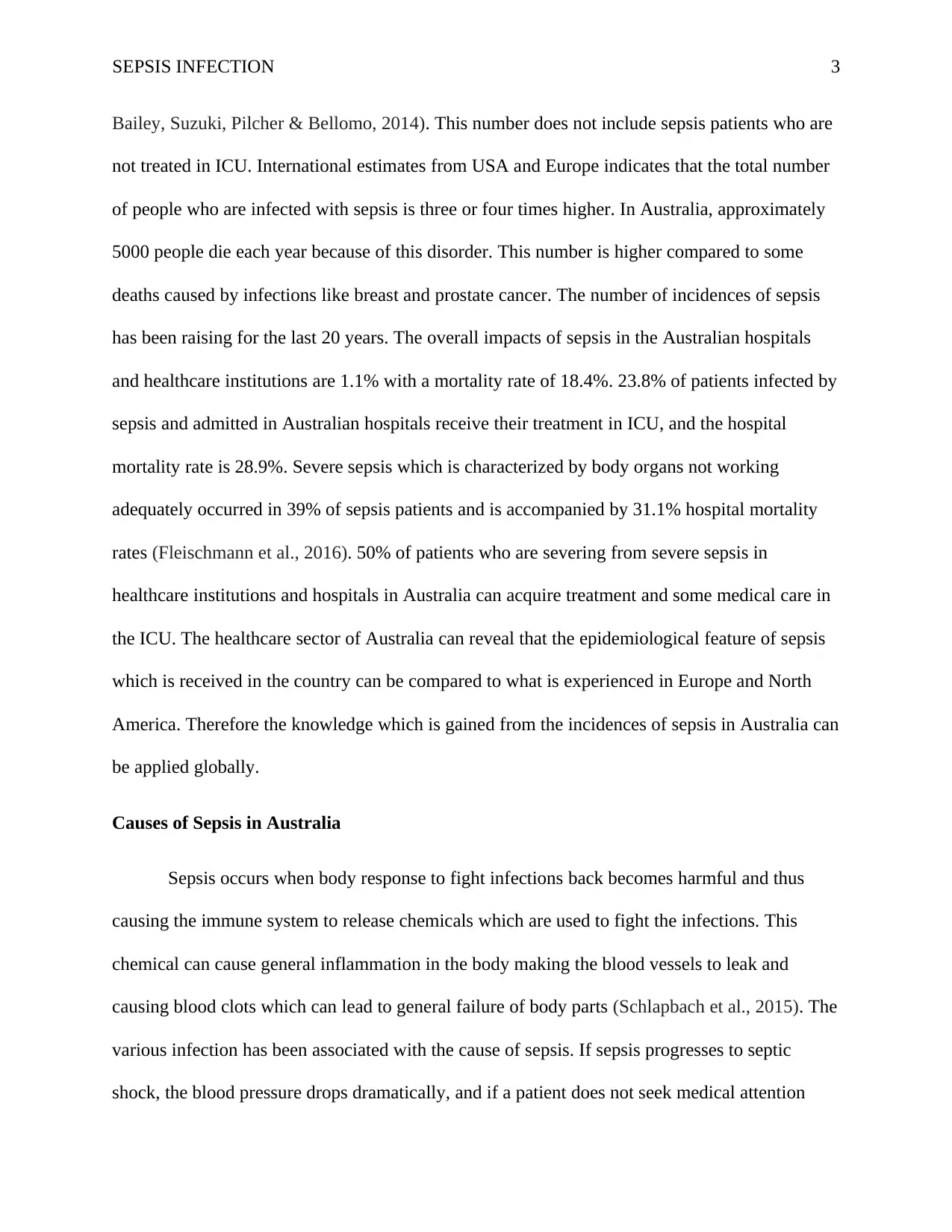
SEPSIS INFECTION 3
Bailey, Suzuki, Pilcher & Bellomo, 2014). This number does not include sepsis patients who are
not treated in ICU. International estimates from USA and Europe indicates that the total number
of people who are infected with sepsis is three or four times higher. In Australia, approximately
5000 people die each year because of this disorder. This number is higher compared to some
deaths caused by infections like breast and prostate cancer. The number of incidences of sepsis
has been raising for the last 20 years. The overall impacts of sepsis in the Australian hospitals
and healthcare institutions are 1.1% with a mortality rate of 18.4%. 23.8% of patients infected by
sepsis and admitted in Australian hospitals receive their treatment in ICU, and the hospital
mortality rate is 28.9%. Severe sepsis which is characterized by body organs not working
adequately occurred in 39% of sepsis patients and is accompanied by 31.1% hospital mortality
rates (Fleischmann et al., 2016). 50% of patients who are severing from severe sepsis in
healthcare institutions and hospitals in Australia can acquire treatment and some medical care in
the ICU. The healthcare sector of Australia can reveal that the epidemiological feature of sepsis
which is received in the country can be compared to what is experienced in Europe and North
America. Therefore the knowledge which is gained from the incidences of sepsis in Australia can
be applied globally.
Causes of Sepsis in Australia
Sepsis occurs when body response to fight infections back becomes harmful and thus
causing the immune system to release chemicals which are used to fight the infections. This
chemical can cause general inflammation in the body making the blood vessels to leak and
causing blood clots which can lead to general failure of body parts (Schlapbach et al., 2015). The
various infection has been associated with the cause of sepsis. If sepsis progresses to septic
shock, the blood pressure drops dramatically, and if a patient does not seek medical attention
Bailey, Suzuki, Pilcher & Bellomo, 2014). This number does not include sepsis patients who are
not treated in ICU. International estimates from USA and Europe indicates that the total number
of people who are infected with sepsis is three or four times higher. In Australia, approximately
5000 people die each year because of this disorder. This number is higher compared to some
deaths caused by infections like breast and prostate cancer. The number of incidences of sepsis
has been raising for the last 20 years. The overall impacts of sepsis in the Australian hospitals
and healthcare institutions are 1.1% with a mortality rate of 18.4%. 23.8% of patients infected by
sepsis and admitted in Australian hospitals receive their treatment in ICU, and the hospital
mortality rate is 28.9%. Severe sepsis which is characterized by body organs not working
adequately occurred in 39% of sepsis patients and is accompanied by 31.1% hospital mortality
rates (Fleischmann et al., 2016). 50% of patients who are severing from severe sepsis in
healthcare institutions and hospitals in Australia can acquire treatment and some medical care in
the ICU. The healthcare sector of Australia can reveal that the epidemiological feature of sepsis
which is received in the country can be compared to what is experienced in Europe and North
America. Therefore the knowledge which is gained from the incidences of sepsis in Australia can
be applied globally.
Causes of Sepsis in Australia
Sepsis occurs when body response to fight infections back becomes harmful and thus
causing the immune system to release chemicals which are used to fight the infections. This
chemical can cause general inflammation in the body making the blood vessels to leak and
causing blood clots which can lead to general failure of body parts (Schlapbach et al., 2015). The
various infection has been associated with the cause of sepsis. If sepsis progresses to septic
shock, the blood pressure drops dramatically, and if a patient does not seek medical attention
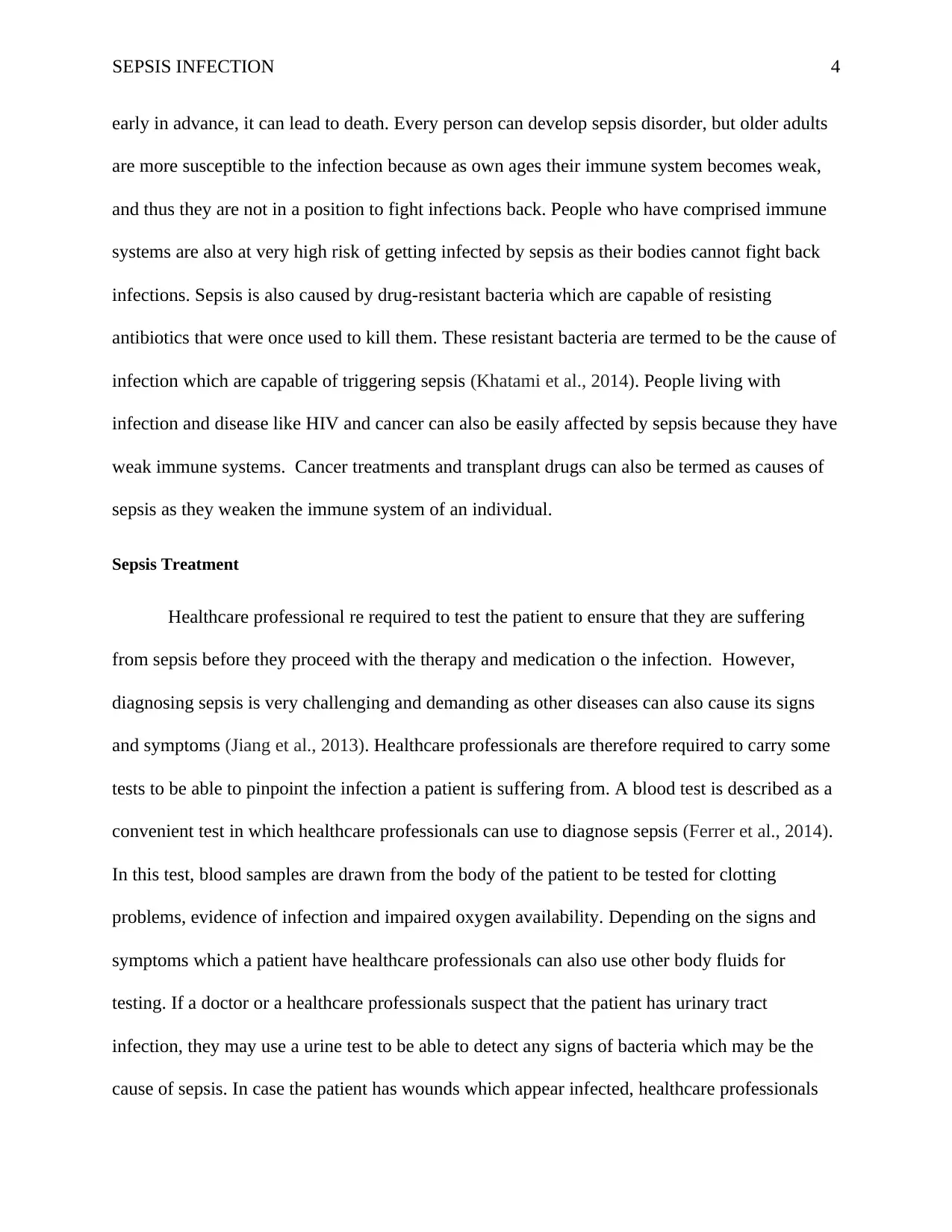
SEPSIS INFECTION 4
early in advance, it can lead to death. Every person can develop sepsis disorder, but older adults
are more susceptible to the infection because as own ages their immune system becomes weak,
and thus they are not in a position to fight infections back. People who have comprised immune
systems are also at very high risk of getting infected by sepsis as their bodies cannot fight back
infections. Sepsis is also caused by drug-resistant bacteria which are capable of resisting
antibiotics that were once used to kill them. These resistant bacteria are termed to be the cause of
infection which are capable of triggering sepsis (Khatami et al., 2014). People living with
infection and disease like HIV and cancer can also be easily affected by sepsis because they have
weak immune systems. Cancer treatments and transplant drugs can also be termed as causes of
sepsis as they weaken the immune system of an individual.
Sepsis Treatment
Healthcare professional re required to test the patient to ensure that they are suffering
from sepsis before they proceed with the therapy and medication o the infection. However,
diagnosing sepsis is very challenging and demanding as other diseases can also cause its signs
and symptoms (Jiang et al., 2013). Healthcare professionals are therefore required to carry some
tests to be able to pinpoint the infection a patient is suffering from. A blood test is described as a
convenient test in which healthcare professionals can use to diagnose sepsis (Ferrer et al., 2014).
In this test, blood samples are drawn from the body of the patient to be tested for clotting
problems, evidence of infection and impaired oxygen availability. Depending on the signs and
symptoms which a patient have healthcare professionals can also use other body fluids for
testing. If a doctor or a healthcare professionals suspect that the patient has urinary tract
infection, they may use a urine test to be able to detect any signs of bacteria which may be the
cause of sepsis. In case the patient has wounds which appear infected, healthcare professionals
early in advance, it can lead to death. Every person can develop sepsis disorder, but older adults
are more susceptible to the infection because as own ages their immune system becomes weak,
and thus they are not in a position to fight infections back. People who have comprised immune
systems are also at very high risk of getting infected by sepsis as their bodies cannot fight back
infections. Sepsis is also caused by drug-resistant bacteria which are capable of resisting
antibiotics that were once used to kill them. These resistant bacteria are termed to be the cause of
infection which are capable of triggering sepsis (Khatami et al., 2014). People living with
infection and disease like HIV and cancer can also be easily affected by sepsis because they have
weak immune systems. Cancer treatments and transplant drugs can also be termed as causes of
sepsis as they weaken the immune system of an individual.
Sepsis Treatment
Healthcare professional re required to test the patient to ensure that they are suffering
from sepsis before they proceed with the therapy and medication o the infection. However,
diagnosing sepsis is very challenging and demanding as other diseases can also cause its signs
and symptoms (Jiang et al., 2013). Healthcare professionals are therefore required to carry some
tests to be able to pinpoint the infection a patient is suffering from. A blood test is described as a
convenient test in which healthcare professionals can use to diagnose sepsis (Ferrer et al., 2014).
In this test, blood samples are drawn from the body of the patient to be tested for clotting
problems, evidence of infection and impaired oxygen availability. Depending on the signs and
symptoms which a patient have healthcare professionals can also use other body fluids for
testing. If a doctor or a healthcare professionals suspect that the patient has urinary tract
infection, they may use a urine test to be able to detect any signs of bacteria which may be the
cause of sepsis. In case the patient has wounds which appear infected, healthcare professionals
Secure Best Marks with AI Grader
Need help grading? Try our AI Grader for instant feedback on your assignments.
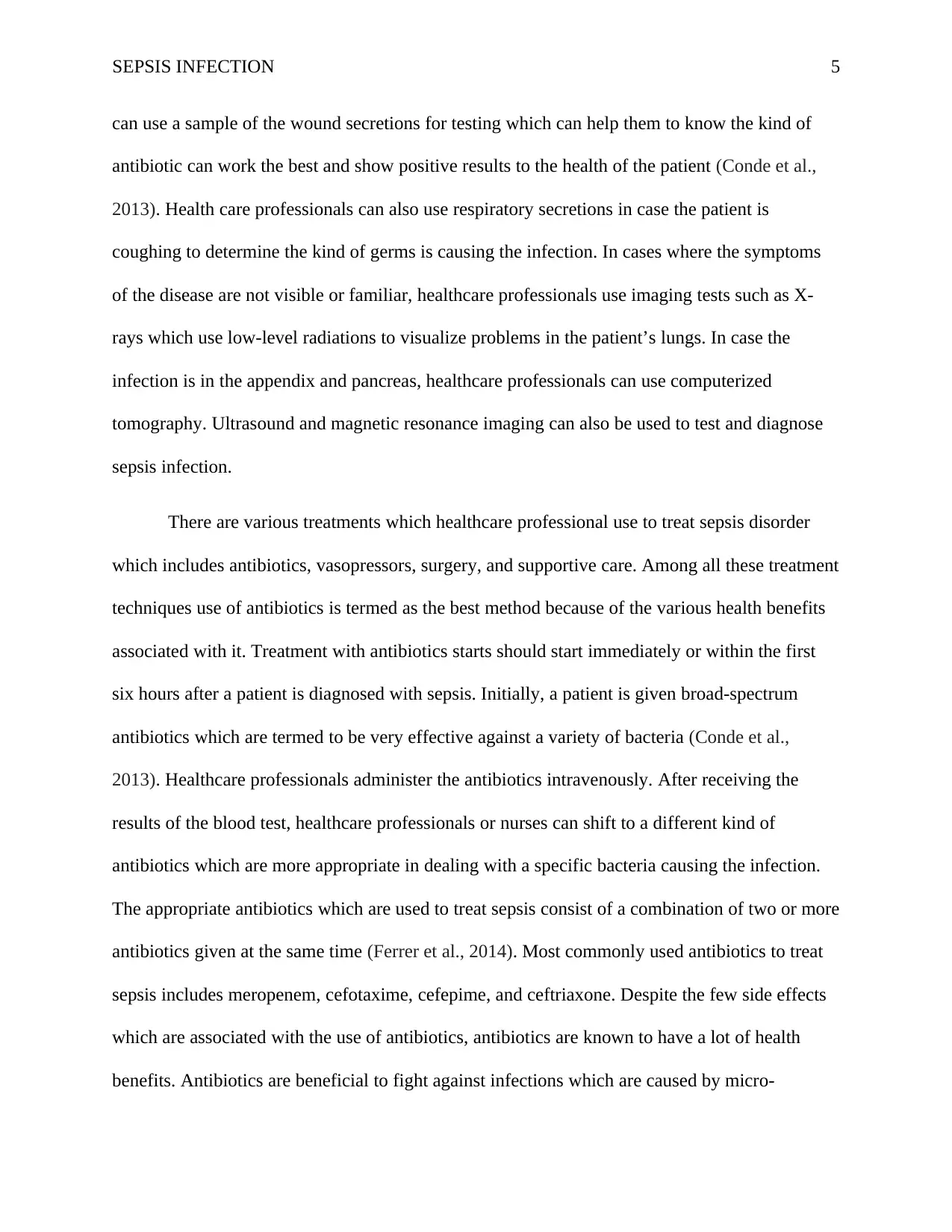
SEPSIS INFECTION 5
can use a sample of the wound secretions for testing which can help them to know the kind of
antibiotic can work the best and show positive results to the health of the patient (Conde et al.,
2013). Health care professionals can also use respiratory secretions in case the patient is
coughing to determine the kind of germs is causing the infection. In cases where the symptoms
of the disease are not visible or familiar, healthcare professionals use imaging tests such as X-
rays which use low-level radiations to visualize problems in the patient’s lungs. In case the
infection is in the appendix and pancreas, healthcare professionals can use computerized
tomography. Ultrasound and magnetic resonance imaging can also be used to test and diagnose
sepsis infection.
There are various treatments which healthcare professional use to treat sepsis disorder
which includes antibiotics, vasopressors, surgery, and supportive care. Among all these treatment
techniques use of antibiotics is termed as the best method because of the various health benefits
associated with it. Treatment with antibiotics starts should start immediately or within the first
six hours after a patient is diagnosed with sepsis. Initially, a patient is given broad-spectrum
antibiotics which are termed to be very effective against a variety of bacteria (Conde et al.,
2013). Healthcare professionals administer the antibiotics intravenously. After receiving the
results of the blood test, healthcare professionals or nurses can shift to a different kind of
antibiotics which are more appropriate in dealing with a specific bacteria causing the infection.
The appropriate antibiotics which are used to treat sepsis consist of a combination of two or more
antibiotics given at the same time (Ferrer et al., 2014). Most commonly used antibiotics to treat
sepsis includes meropenem, cefotaxime, cefepime, and ceftriaxone. Despite the few side effects
which are associated with the use of antibiotics, antibiotics are known to have a lot of health
benefits. Antibiotics are beneficial to fight against infections which are caused by micro-
can use a sample of the wound secretions for testing which can help them to know the kind of
antibiotic can work the best and show positive results to the health of the patient (Conde et al.,
2013). Health care professionals can also use respiratory secretions in case the patient is
coughing to determine the kind of germs is causing the infection. In cases where the symptoms
of the disease are not visible or familiar, healthcare professionals use imaging tests such as X-
rays which use low-level radiations to visualize problems in the patient’s lungs. In case the
infection is in the appendix and pancreas, healthcare professionals can use computerized
tomography. Ultrasound and magnetic resonance imaging can also be used to test and diagnose
sepsis infection.
There are various treatments which healthcare professional use to treat sepsis disorder
which includes antibiotics, vasopressors, surgery, and supportive care. Among all these treatment
techniques use of antibiotics is termed as the best method because of the various health benefits
associated with it. Treatment with antibiotics starts should start immediately or within the first
six hours after a patient is diagnosed with sepsis. Initially, a patient is given broad-spectrum
antibiotics which are termed to be very effective against a variety of bacteria (Conde et al.,
2013). Healthcare professionals administer the antibiotics intravenously. After receiving the
results of the blood test, healthcare professionals or nurses can shift to a different kind of
antibiotics which are more appropriate in dealing with a specific bacteria causing the infection.
The appropriate antibiotics which are used to treat sepsis consist of a combination of two or more
antibiotics given at the same time (Ferrer et al., 2014). Most commonly used antibiotics to treat
sepsis includes meropenem, cefotaxime, cefepime, and ceftriaxone. Despite the few side effects
which are associated with the use of antibiotics, antibiotics are known to have a lot of health
benefits. Antibiotics are beneficial to fight against infections which are caused by micro-
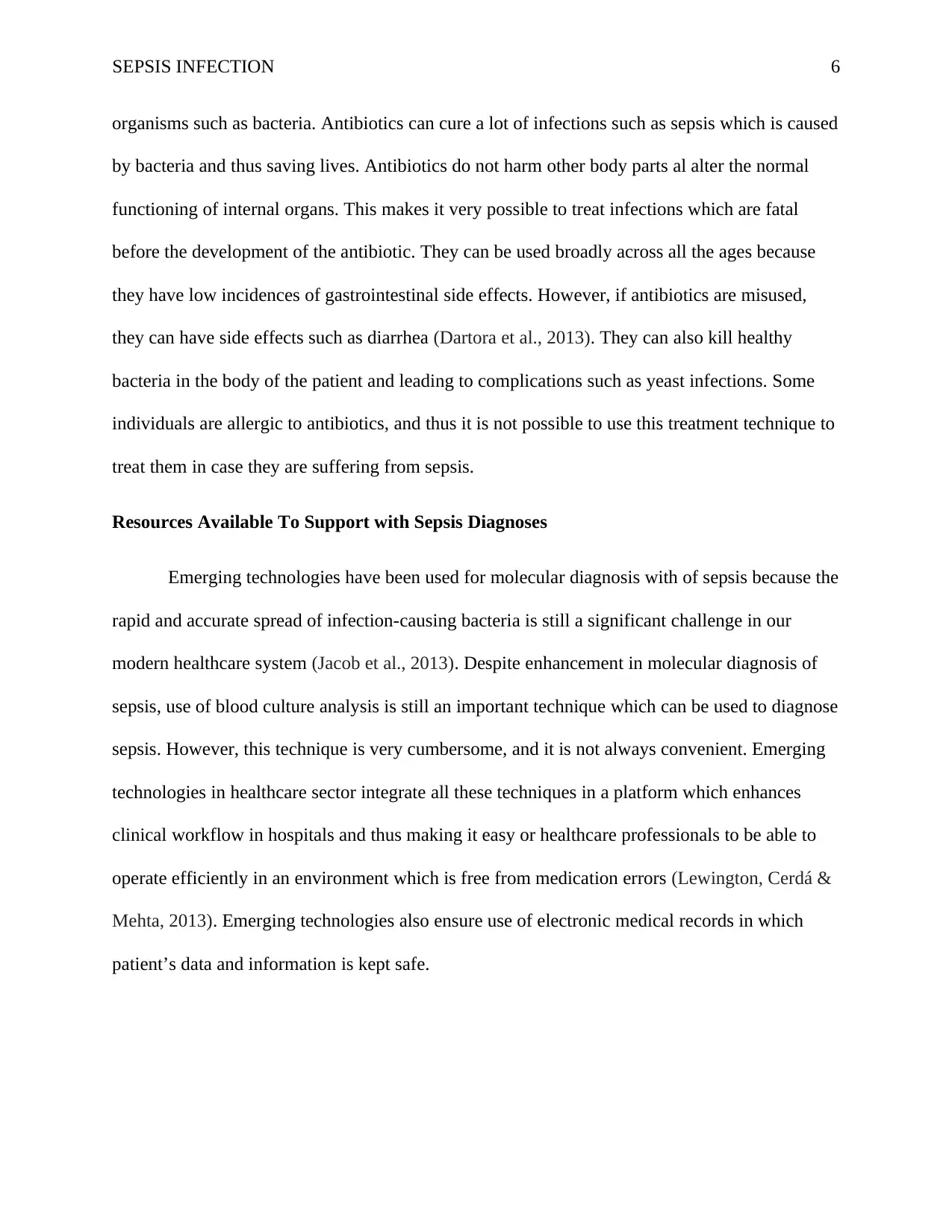
SEPSIS INFECTION 6
organisms such as bacteria. Antibiotics can cure a lot of infections such as sepsis which is caused
by bacteria and thus saving lives. Antibiotics do not harm other body parts al alter the normal
functioning of internal organs. This makes it very possible to treat infections which are fatal
before the development of the antibiotic. They can be used broadly across all the ages because
they have low incidences of gastrointestinal side effects. However, if antibiotics are misused,
they can have side effects such as diarrhea (Dartora et al., 2013). They can also kill healthy
bacteria in the body of the patient and leading to complications such as yeast infections. Some
individuals are allergic to antibiotics, and thus it is not possible to use this treatment technique to
treat them in case they are suffering from sepsis.
Resources Available To Support with Sepsis Diagnoses
Emerging technologies have been used for molecular diagnosis with of sepsis because the
rapid and accurate spread of infection-causing bacteria is still a significant challenge in our
modern healthcare system (Jacob et al., 2013). Despite enhancement in molecular diagnosis of
sepsis, use of blood culture analysis is still an important technique which can be used to diagnose
sepsis. However, this technique is very cumbersome, and it is not always convenient. Emerging
technologies in healthcare sector integrate all these techniques in a platform which enhances
clinical workflow in hospitals and thus making it easy or healthcare professionals to be able to
operate efficiently in an environment which is free from medication errors (Lewington, Cerdá &
Mehta, 2013). Emerging technologies also ensure use of electronic medical records in which
patient’s data and information is kept safe.
organisms such as bacteria. Antibiotics can cure a lot of infections such as sepsis which is caused
by bacteria and thus saving lives. Antibiotics do not harm other body parts al alter the normal
functioning of internal organs. This makes it very possible to treat infections which are fatal
before the development of the antibiotic. They can be used broadly across all the ages because
they have low incidences of gastrointestinal side effects. However, if antibiotics are misused,
they can have side effects such as diarrhea (Dartora et al., 2013). They can also kill healthy
bacteria in the body of the patient and leading to complications such as yeast infections. Some
individuals are allergic to antibiotics, and thus it is not possible to use this treatment technique to
treat them in case they are suffering from sepsis.
Resources Available To Support with Sepsis Diagnoses
Emerging technologies have been used for molecular diagnosis with of sepsis because the
rapid and accurate spread of infection-causing bacteria is still a significant challenge in our
modern healthcare system (Jacob et al., 2013). Despite enhancement in molecular diagnosis of
sepsis, use of blood culture analysis is still an important technique which can be used to diagnose
sepsis. However, this technique is very cumbersome, and it is not always convenient. Emerging
technologies in healthcare sector integrate all these techniques in a platform which enhances
clinical workflow in hospitals and thus making it easy or healthcare professionals to be able to
operate efficiently in an environment which is free from medication errors (Lewington, Cerdá &
Mehta, 2013). Emerging technologies also ensure use of electronic medical records in which
patient’s data and information is kept safe.
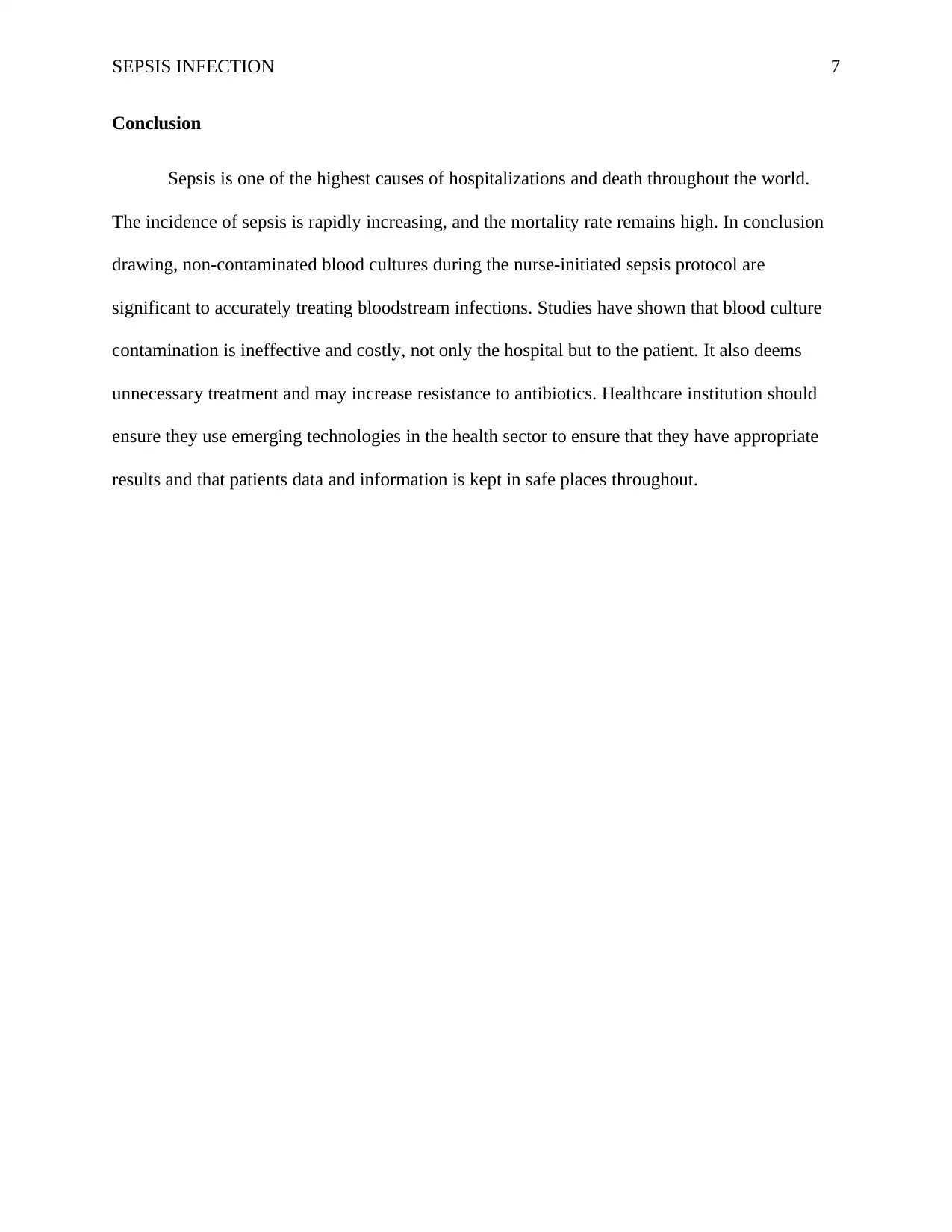
SEPSIS INFECTION 7
Conclusion
Sepsis is one of the highest causes of hospitalizations and death throughout the world.
The incidence of sepsis is rapidly increasing, and the mortality rate remains high. In conclusion
drawing, non-contaminated blood cultures during the nurse-initiated sepsis protocol are
significant to accurately treating bloodstream infections. Studies have shown that blood culture
contamination is ineffective and costly, not only the hospital but to the patient. It also deems
unnecessary treatment and may increase resistance to antibiotics. Healthcare institution should
ensure they use emerging technologies in the health sector to ensure that they have appropriate
results and that patients data and information is kept in safe places throughout.
Conclusion
Sepsis is one of the highest causes of hospitalizations and death throughout the world.
The incidence of sepsis is rapidly increasing, and the mortality rate remains high. In conclusion
drawing, non-contaminated blood cultures during the nurse-initiated sepsis protocol are
significant to accurately treating bloodstream infections. Studies have shown that blood culture
contamination is ineffective and costly, not only the hospital but to the patient. It also deems
unnecessary treatment and may increase resistance to antibiotics. Healthcare institution should
ensure they use emerging technologies in the health sector to ensure that they have appropriate
results and that patients data and information is kept in safe places throughout.
Paraphrase This Document
Need a fresh take? Get an instant paraphrase of this document with our AI Paraphraser
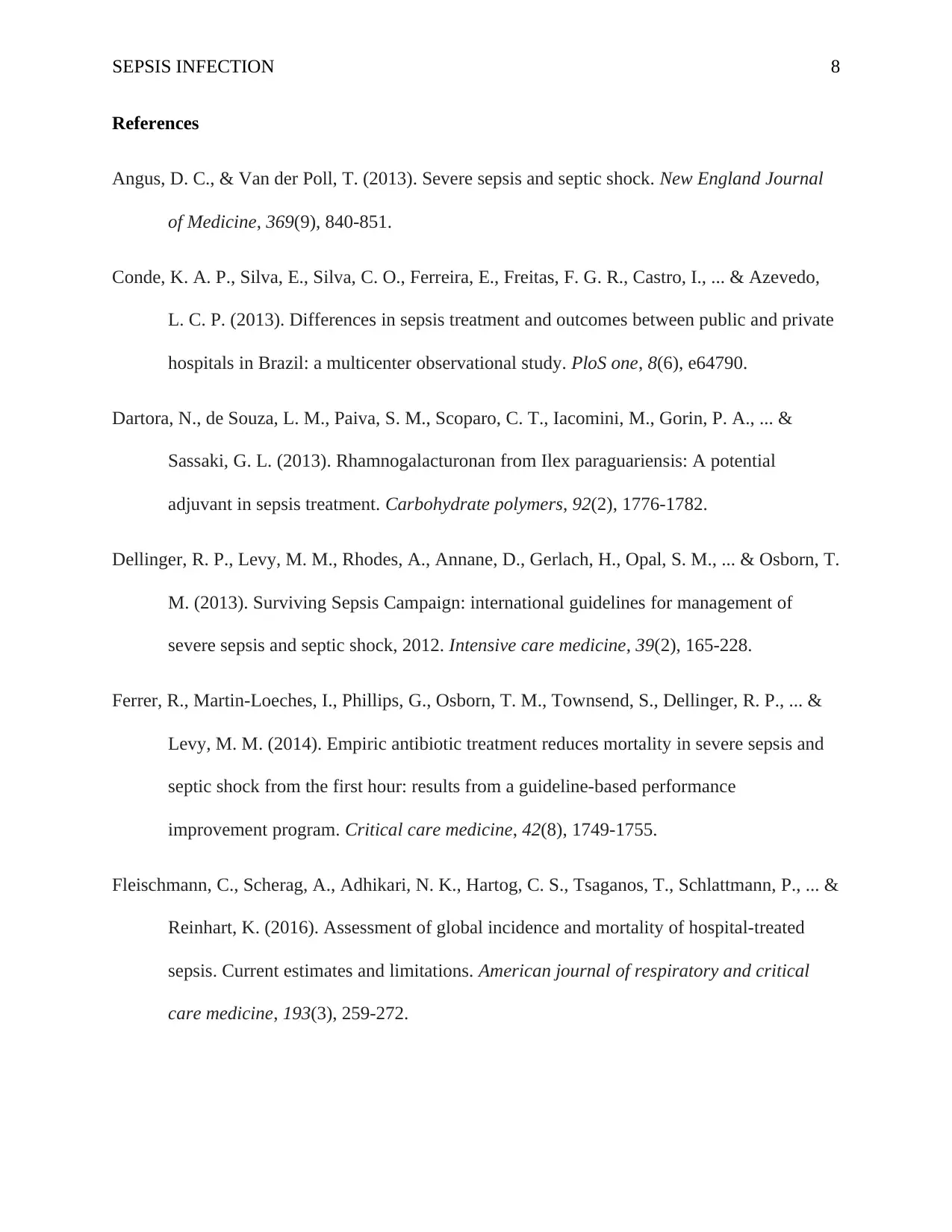
SEPSIS INFECTION 8
References
Angus, D. C., & Van der Poll, T. (2013). Severe sepsis and septic shock. New England Journal
of Medicine, 369(9), 840-851.
Conde, K. A. P., Silva, E., Silva, C. O., Ferreira, E., Freitas, F. G. R., Castro, I., ... & Azevedo,
L. C. P. (2013). Differences in sepsis treatment and outcomes between public and private
hospitals in Brazil: a multicenter observational study. PloS one, 8(6), e64790.
Dartora, N., de Souza, L. M., Paiva, S. M., Scoparo, C. T., Iacomini, M., Gorin, P. A., ... &
Sassaki, G. L. (2013). Rhamnogalacturonan from Ilex paraguariensis: A potential
adjuvant in sepsis treatment. Carbohydrate polymers, 92(2), 1776-1782.
Dellinger, R. P., Levy, M. M., Rhodes, A., Annane, D., Gerlach, H., Opal, S. M., ... & Osborn, T.
M. (2013). Surviving Sepsis Campaign: international guidelines for management of
severe sepsis and septic shock, 2012. Intensive care medicine, 39(2), 165-228.
Ferrer, R., Martin-Loeches, I., Phillips, G., Osborn, T. M., Townsend, S., Dellinger, R. P., ... &
Levy, M. M. (2014). Empiric antibiotic treatment reduces mortality in severe sepsis and
septic shock from the first hour: results from a guideline-based performance
improvement program. Critical care medicine, 42(8), 1749-1755.
Fleischmann, C., Scherag, A., Adhikari, N. K., Hartog, C. S., Tsaganos, T., Schlattmann, P., ... &
Reinhart, K. (2016). Assessment of global incidence and mortality of hospital-treated
sepsis. Current estimates and limitations. American journal of respiratory and critical
care medicine, 193(3), 259-272.
References
Angus, D. C., & Van der Poll, T. (2013). Severe sepsis and septic shock. New England Journal
of Medicine, 369(9), 840-851.
Conde, K. A. P., Silva, E., Silva, C. O., Ferreira, E., Freitas, F. G. R., Castro, I., ... & Azevedo,
L. C. P. (2013). Differences in sepsis treatment and outcomes between public and private
hospitals in Brazil: a multicenter observational study. PloS one, 8(6), e64790.
Dartora, N., de Souza, L. M., Paiva, S. M., Scoparo, C. T., Iacomini, M., Gorin, P. A., ... &
Sassaki, G. L. (2013). Rhamnogalacturonan from Ilex paraguariensis: A potential
adjuvant in sepsis treatment. Carbohydrate polymers, 92(2), 1776-1782.
Dellinger, R. P., Levy, M. M., Rhodes, A., Annane, D., Gerlach, H., Opal, S. M., ... & Osborn, T.
M. (2013). Surviving Sepsis Campaign: international guidelines for management of
severe sepsis and septic shock, 2012. Intensive care medicine, 39(2), 165-228.
Ferrer, R., Martin-Loeches, I., Phillips, G., Osborn, T. M., Townsend, S., Dellinger, R. P., ... &
Levy, M. M. (2014). Empiric antibiotic treatment reduces mortality in severe sepsis and
septic shock from the first hour: results from a guideline-based performance
improvement program. Critical care medicine, 42(8), 1749-1755.
Fleischmann, C., Scherag, A., Adhikari, N. K., Hartog, C. S., Tsaganos, T., Schlattmann, P., ... &
Reinhart, K. (2016). Assessment of global incidence and mortality of hospital-treated
sepsis. Current estimates and limitations. American journal of respiratory and critical
care medicine, 193(3), 259-272.
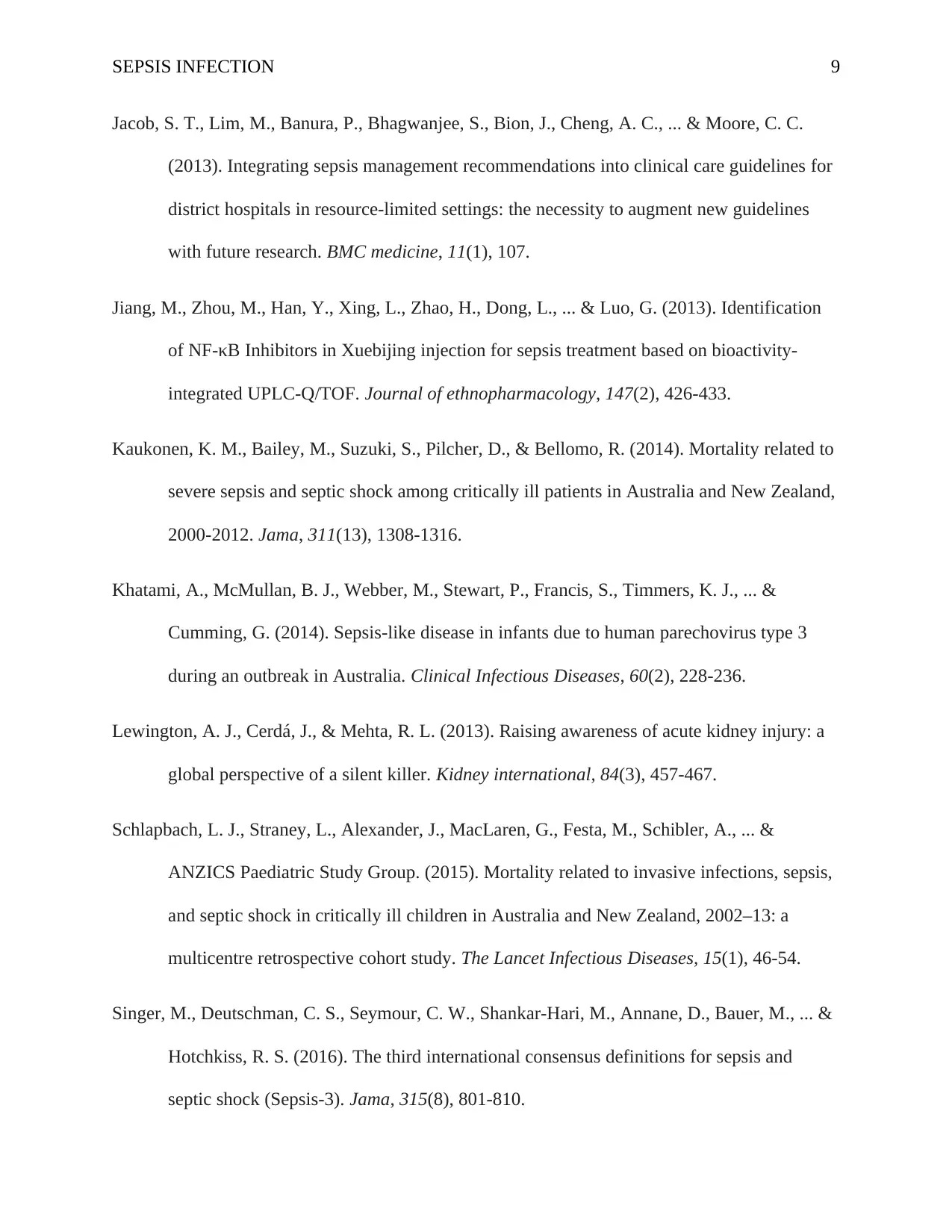
SEPSIS INFECTION 9
Jacob, S. T., Lim, M., Banura, P., Bhagwanjee, S., Bion, J., Cheng, A. C., ... & Moore, C. C.
(2013). Integrating sepsis management recommendations into clinical care guidelines for
district hospitals in resource-limited settings: the necessity to augment new guidelines
with future research. BMC medicine, 11(1), 107.
Jiang, M., Zhou, M., Han, Y., Xing, L., Zhao, H., Dong, L., ... & Luo, G. (2013). Identification
of NF-κB Inhibitors in Xuebijing injection for sepsis treatment based on bioactivity-
integrated UPLC-Q/TOF. Journal of ethnopharmacology, 147(2), 426-433.
Kaukonen, K. M., Bailey, M., Suzuki, S., Pilcher, D., & Bellomo, R. (2014). Mortality related to
severe sepsis and septic shock among critically ill patients in Australia and New Zealand,
2000-2012. Jama, 311(13), 1308-1316.
Khatami, A., McMullan, B. J., Webber, M., Stewart, P., Francis, S., Timmers, K. J., ... &
Cumming, G. (2014). Sepsis-like disease in infants due to human parechovirus type 3
during an outbreak in Australia. Clinical Infectious Diseases, 60(2), 228-236.
Lewington, A. J., Cerdá, J., & Mehta, R. L. (2013). Raising awareness of acute kidney injury: a
global perspective of a silent killer. Kidney international, 84(3), 457-467.
Schlapbach, L. J., Straney, L., Alexander, J., MacLaren, G., Festa, M., Schibler, A., ... &
ANZICS Paediatric Study Group. (2015). Mortality related to invasive infections, sepsis,
and septic shock in critically ill children in Australia and New Zealand, 2002–13: a
multicentre retrospective cohort study. The Lancet Infectious Diseases, 15(1), 46-54.
Singer, M., Deutschman, C. S., Seymour, C. W., Shankar-Hari, M., Annane, D., Bauer, M., ... &
Hotchkiss, R. S. (2016). The third international consensus definitions for sepsis and
septic shock (Sepsis-3). Jama, 315(8), 801-810.
Jacob, S. T., Lim, M., Banura, P., Bhagwanjee, S., Bion, J., Cheng, A. C., ... & Moore, C. C.
(2013). Integrating sepsis management recommendations into clinical care guidelines for
district hospitals in resource-limited settings: the necessity to augment new guidelines
with future research. BMC medicine, 11(1), 107.
Jiang, M., Zhou, M., Han, Y., Xing, L., Zhao, H., Dong, L., ... & Luo, G. (2013). Identification
of NF-κB Inhibitors in Xuebijing injection for sepsis treatment based on bioactivity-
integrated UPLC-Q/TOF. Journal of ethnopharmacology, 147(2), 426-433.
Kaukonen, K. M., Bailey, M., Suzuki, S., Pilcher, D., & Bellomo, R. (2014). Mortality related to
severe sepsis and septic shock among critically ill patients in Australia and New Zealand,
2000-2012. Jama, 311(13), 1308-1316.
Khatami, A., McMullan, B. J., Webber, M., Stewart, P., Francis, S., Timmers, K. J., ... &
Cumming, G. (2014). Sepsis-like disease in infants due to human parechovirus type 3
during an outbreak in Australia. Clinical Infectious Diseases, 60(2), 228-236.
Lewington, A. J., Cerdá, J., & Mehta, R. L. (2013). Raising awareness of acute kidney injury: a
global perspective of a silent killer. Kidney international, 84(3), 457-467.
Schlapbach, L. J., Straney, L., Alexander, J., MacLaren, G., Festa, M., Schibler, A., ... &
ANZICS Paediatric Study Group. (2015). Mortality related to invasive infections, sepsis,
and septic shock in critically ill children in Australia and New Zealand, 2002–13: a
multicentre retrospective cohort study. The Lancet Infectious Diseases, 15(1), 46-54.
Singer, M., Deutschman, C. S., Seymour, C. W., Shankar-Hari, M., Annane, D., Bauer, M., ... &
Hotchkiss, R. S. (2016). The third international consensus definitions for sepsis and
septic shock (Sepsis-3). Jama, 315(8), 801-810.

SEPSIS INFECTION 10
1 out of 10
Related Documents
Your All-in-One AI-Powered Toolkit for Academic Success.
+13062052269
info@desklib.com
Available 24*7 on WhatsApp / Email
![[object Object]](/_next/static/media/star-bottom.7253800d.svg)
Unlock your academic potential
© 2024 | Zucol Services PVT LTD | All rights reserved.





